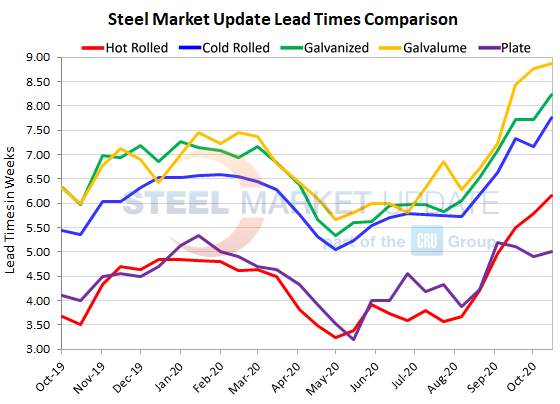SMU Data and Models

Steel Mill Lead Times: Extend to 6-8 Weeks
Written by Tim Triplett
October 15, 2020
Lead times for hot rolled steel now average longer than six weeks, and coated steel orders longer than eight weeks, as the mills remain busy in a market adjusting to business in a pandemic. Lead times are an indicator of steel demand—longer lead times indicate the mills have more orders to process and are less likely to negotiate on prices.
According to Steel Market Update’s check of the market this week, hot rolled lead times now average 6.15 weeks, up from 5.78 two weeks ago and 5.50 weeks at this time last month. HR lead times have stretched by nearly three weeks since hitting 3.25 weeks at the low point in April.
Cold rolled lead times are at 7.77 weeks, up from 7.17 in SMU’s last check of the market, and 7.32 weeks in mid-September. Cold rolled lead times are more than two and a half weeks longer than in late April.
Galvanized lead times are have jumped out to 8.24 weeks, up from 7.73 weeks in early October. The current average Galvalume lead time is up to 8.86 weeks as Galvalume supplies remain tight.
Plate lead times have been fairly flat in September and October at around 5.00 weeks, plus or minus, as plate demand and pricing have been hurt by weakness in the energy and commercial construction markets.
Looking at three-month moving averages, which smooth out the variability in the biweekly readings, lead times for flat rolled and plate have continued moving outward since late June. The current 3MMA for hot rolled is 5.05 weeks, cold rolled is 6.80 weeks, galvanized is 7.23 weeks, Galvalume is 7.72 weeks and plate is 4.72 weeks.
Some early indications suggest that steel prices may be nearing a peak. Steel Market Update will be keeping a close watch for signs that lead times are beginning to shorten.
Note: These lead times are based on the average from manufacturers and steel service centers who participated in this week’s SMU market trends analysis. Our lead times do not predict what any individual may get from any specific mill supplier. Look to your mill rep for actual lead times. Our lead times are meant only to identify trends and changes in the marketplace. To see an interactive history of our Steel Mill Lead Times data, visit our website here.



Tim Triplett
Read more from Tim TriplettLatest in SMU Data and Models

SMU Survey: Sheet lead times ease further, plate hits one-year high
Steel buyers responding to this week’s SMU market survey report a continued softening in sheet lead times. Meanwhile, plate lead times have moderately extended and are at a one-year high.

SMU Survey: Buyers report more price flexibility from mills
Nearly half of the steel buyers responding to this week’s SMU market survey say domestic mills are showing increased willingness to negotiate pricing on new spot orders. This marks a significant shift from the firmer stance mills held in prior weeks.

SMU Survey: Buyers’ Sentiment Indices fall
Current Sentiment Index dropped six points to +42 this week compared to two weeks earlier. It has fallen in every successive survey since reaching a 2025 high of +66 on Feb. 19.

March service center shipments and inventories report
Steel service center shipments and inventories report through March 2024.

Apparent steel supply contracts in February
The amount of finished steel that entered the US market in February receded from January’s peak, according to our analysis of Department of Commerce and American Iron and Steel Institute (AISI) data.
